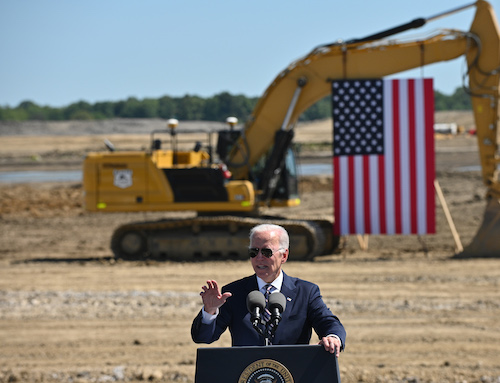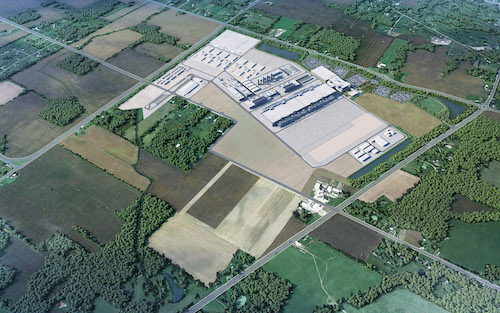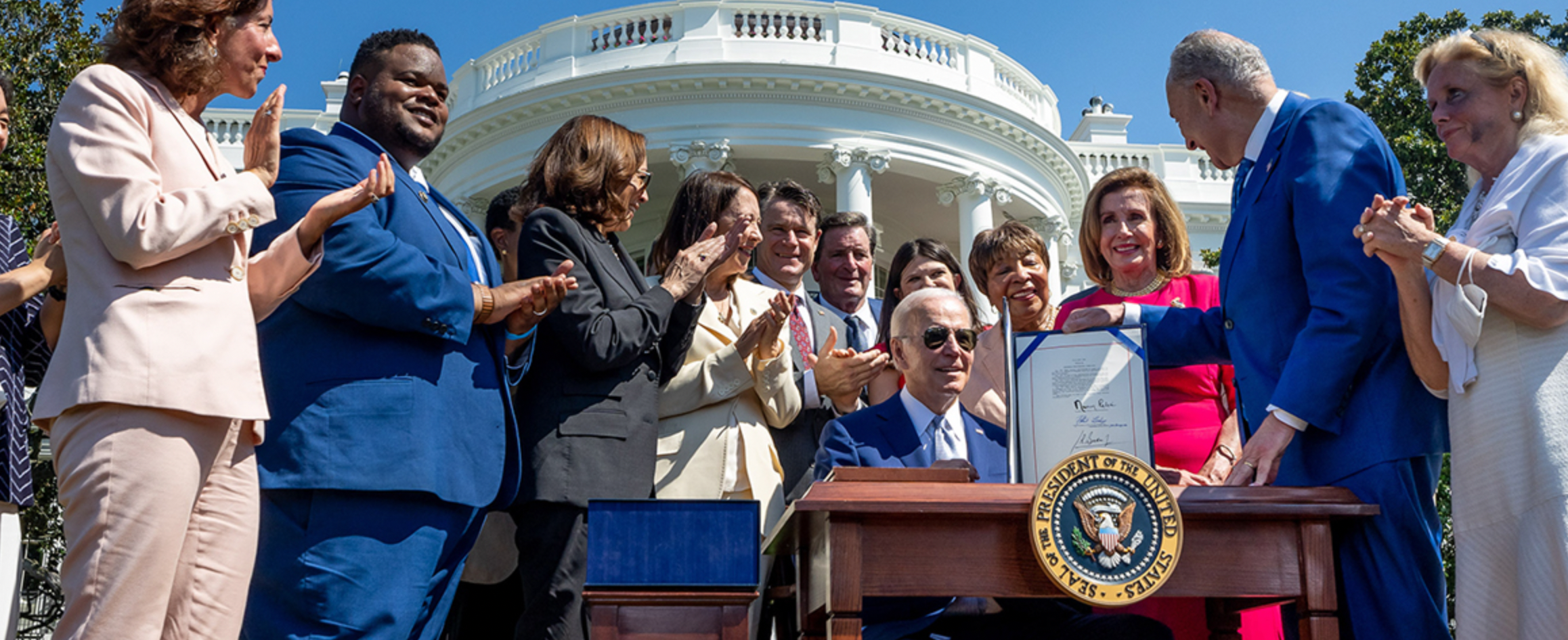Ohio Chip Plant Soars to $100 Billion After Biden-Backed Legislation.
 |
| Following the passage of the CHIPS Act, thousands of New Albany, Ohio, Local 1105 members will be on-site building Intel’s new $100 billion semiconductor complex for decades. By a factor of at least two, it is the largest project labor agreement in IBEW history. Rendering courtesy Intel Corp. |
The largest private investment in Ohio history and the largest project labor agreement in IBEW history broke ground just east of Columbus on Sept. 9.
Intel Corp. expects 7,000 construction workers, including up to 3,000 electrical workers, will be on-site for at least a decade, and likely far, far longer.
The $20 billion Intel semiconductor manufacturing campus was just a rumor last December when Newark Local 1105 Business Manager Bill Hamilton first heard about the project.
“It was the best kept secret,” Hamilton said, comparing it to the silence that preceded the D-Day invasion during World War II. “It is mind-blowing that we went from whispers in December to President Biden name-checking International President Stephenson at the groundbreaking in September.”
Hamilton has been the business manager of Local 1105 since 2001 when he represented about 225 members. When the announcement was made, a decade of data center-driven growth had doubled his membership.
Now, he was looking at a single project that could easily put nearly four times that number to work for a decade.
Intel wasn’t done.
CEO Patrick P. Gelsinger had a message in public and private throughout the spring: If the CHIPS and Science Act passed in Congress, Intel would quintuple the size of the fabrication facility to $100 billion.
“They did not mince words. It was that direct connection between the CHIPS Act and the investment,” Hamilton said.
After an immense lobbying campaign spearheaded by the IBEW, the CHIPS Act passed and President Joe Biden signed it in August, with International President Lonnie R. Stephenson and Fourth District International Vice President Gina Cooper at the White House for the celebration.
The bill created $280 billion in investments, tax credits, and subsidies to bring high-tech manufacturing jobs back to U.S. shores after decades of federal support for sending them overseas.
At press time, Micron Technology, Inc. announced it, too, would be building a gargantuan chip-making facility at home in the U.S. Located in the jurisdiction of Syracuse, N.Y., Local 43, that project could also grow to $100 billion over the next 20 years thanks to the incentives in the CHIPS Act. The Electrical Worker will have additional coverage of that project in an upcoming issue.
 |
| President Joe Biden speaks at the groundbreaking of Stage One of the Ohio Intel plant one month after signing the CHIPS Act. |
Semiconductors are the essential component of digital life, the silicon brain powering every advance in computers, transportation, health care, clean energy, weapons systems, and future technology like artificial intelligence.
The collapse of the global chip supply chain was the source of roughly one-third of the inflation spike that hit the U.S. last summer. Guaranteeing reliable access to semiconductors is a prerequisite to competing in the 21st-century world.
The U.S. remains the global leader in semiconductor research and design, but U.S. chip manufacturing, which once supplied nearly 30% of the world’s microchips, had fallen to just 10% in 2022. The CHIPS Act recognized a fundamental flaw in the global economy — access to new microchips had become not just an economic concern, but a national security necessity.
Good as his word, just before the official groundbreaking, Gelsinger confirmed that the promise was real: what was already the largest private investment in the state was now just the first and smallest phase of a $100 billion industrial complex that could change the economy of the entire Midwest.
“Intel is using a PLA. For folks at home, these are agreements that contractors, subcontractors and unions put in place before construction begins,” Biden said at the groundbreaking. “They ensure major projects are handled by well-trained, well-prepared, highly skilled workers. These agreements make sure construction is top-notch, on time, on task, and on budget.”
Stage One will now exhaust the entire $20 billion initial investment; Stage Two will be twice as big, and by the time construction starts on Stage Three, Intel will already be updating Stage One, Cooper said.
“This is extraordinary news for Local 1105, the state of Ohio, and the entire IBEW,” she said.
The challenge for the IBEW and its signatory contractors now, she said, is creating and organizing a union workforce large enough to handle this job without ceding a single foot of conduit to nonunion contractors in the jurisdiction.
Exponential Growth
 |
| The campus site is farmland today, but dozens of Intel suppliers have already announced plans to build in the area and housing, commercial and retail development is expected to follow. Rendering courtesy Intel Corp. |
 |
| The groundbreaking in September was for a $20 billion Stage One; after the CHIPS Act was passed, Intel announced two more phases at $40 billion each. Image courtesy Intel Corp. |
 |
| Semiconductor fabs are unlike any other kind of manufacturing. The tools are hundreds of tons, cost hundreds of millions of dollars and are replaced regularly meaning decades of work for a dedicated workforce of electricians. Rendering courtesy Intel Corp. |
Five years ago, Local 1105 looked a lot like it had for the previous 40 years when it was formed by the consolidation of five construction locals. Membership had peaked at about 250 members in the mid-1970s, Hamilton said, and then held steady at about 225.
The heart of the local’s work was a six-unit, 2-gigawatt coal powerhouse in Conesville, Ohio, where Hamilton had done nearly his entire apprenticeship and members worked around the clock.
The five smokestacks of Conesville have been quiet for more than two years, which would have been a disaster for the local. But five years ago, Amazon came to town and built its first data center. Google and Facebook followed, and Amazon returned to build two logistics centers.
Local 1105 began to grow.
“We haven’t stopped,” Hamilton said.
Even before Intel’s announcement, the local had nearly 550 members and there was already a $250 bounty for bringing in nonunion electrical workers who signed a card. The local bought a 15,000-square-foot building to expand the JATC and indentured 130 apprentices last year alone.
Then came the Intel announcement.
Luckily, the eight acres next to the JATC building were available. JATC bought two, and Local 1105 is closing on the other six to build a campus on the site.
“Intel was clear: they don’t want this to be all travelers. They will have enough work, and high enough standards, that they want this to be home,” Hamilton said. “We will grow to meet the need.”
By comparison, an Intel plant in the jurisdiction of Portland, Ore., Local 48 has had an average of 1,200 IBEW members onsite, as many as nearly 2,000 at times, said Business Manager Garth Bachman, but never less than a few hundred — for the last 30 years.
“It is so huge it is really hard to describe,” Bachman said. “And the Ohio site is three times the size of ours.”
And then there are the 160 suppliers that Intel said will locate some part of their production process in the area.
That’s not including the condos, shopping malls, grocery stores, homes and movie theaters that have all popped up in the former farmlands around the Oregon facility.
“It will be absolutely awesome,” Cooper said. “This is a project that never ends. It’s good to be us.”
The prevailing wage standards in the CHIPS Act, the Inflation Reduction Act and the infrastructure bill, all signed by President Biden in the last year, will create an unprecedented opportunity for IBEW locals that are prepared to grab it.
Happily, Cooper said, even though no one knew the IBEW would see the success of these bills, union leadership has been preparing to meet the moment.
“When we met with Intel, we had a plan and we are using every tool, idea and personal connection we have developed in the last two decades of investing in organizing,” she said.
The plan, coordinated by Cooper, Fourth District International Representative Virgil Hamilton, Local 1105’s Billy Hamilton (no relation), Fourth District Organizing Coordinator Donny Rutledge (a former Local 1105 organizer) and the rest of the Fourth District staff includes, well, everything.
“Top-down, bottom-up, social media, community colleges, affinity groups, targeted mailers, door knocking, transition assistance coordinators at every local military base and all 18 JATCs in the state have been told to expand,” Cooper said. “The goal is to increase everything.”
The online home is WePowerOhio.com, based on the WePowerAmerica.com site originally built by the Membership Development Department.
Cooper, Hamilton, and Local 1105 staff, representatives from the National Electrical Contractors Association and Fourth District staff have been meeting with Intel every other week since “very early” in the process, Cooper said.
“Our intent is to prove that we are true partners. We will be there for the long haul, and we will do what is necessary to be successful,” Bill Hamilton said.
There is one advantage to the gargantuan size of the project, Cooper said. It is so big it will have its own gravity.
“There are 23,000 electrical workers in the state, not all of them IBEW. There won’t be many who won’t hear from us, but even they will hear about Intel, the scope, the budget, the time horizon that stretches far beyond just one career,” she said.
Organizing efforts will target foremen, general foremen and supervisors, who often bring along their entire crews. Nonunion contractors listen a little closer to top-down organizing arguments when they are watching their workers walk.
“We welcome any nonunion contractor who wants to take on smaller jobs to come on in and talk with us. Anytime. We will sub work out to everybody who will help fill the gaps. And when the huge jobs slow down, we still control the entire market,” Cooper said. “But we have no intention of giving up an inch of conduit if they don’t sign on.”
Another advantage is the size of the IBEW infrastructure in Ohio.
“I have faith in the strength of our Ohio locals. We have 18 inside locals, two outside locals and two locals outside the state with jurisdiction in Ohio. That means 22 apprenticeships and 22 organizing departments,” she said.
The rest, Cooper said, is working with and through the Electrical Workers Minority Caucus, the Women’s Caucus, Veterans’ Committees, Helmets to Hardhats, community colleges and trade schools and military bases.
“We are throwing everything at this,” she said.
Keeping What We Have
The main worry, if there is one associated with a lifetime of work, is that the mega project, the one that pays over-scale with about 20 hours of overtime a week, will leave open calls for traditional customers and open the door for nonunion contractors to come in and grow in the dark.
Albany, N.Y., Local 236 Business Manager Mike Mastropietro lives with this concern.
The GlobalFoundries chip fabrication facility in his local’s jurisdiction has kept hundreds of the local’s 1,700 members busy since it started construction a decade ago.
“We had half the local on the initial project, including me, and between 50 and 300 since,” he said. “It has been permanent growth.”
Mastropietro said the local faced real challenges finding the members to do all the jurisdiction’s work when the facility first opened, though they were “aided” by the timing. Construction began in the wreckage of the 2008 financial crisis and the membership was grateful for the work.
However, many of the 90 signatory contractors did not meet the bonding requirements to successfully sub work at the facility. Ultimately, he said, help comes to those who help themselves.
“Our members took advantage to fill in the smaller jobs. They were the best resource to keep nonunion contractors from coming in,” he said. “We like to see our members start their own shops and we support them however we can. Plus, existing contractors were lending their experience and know-how.”
It’s an idea that Cooper has embraced as a key component of maintaining market share.
Cooper assigned Virgil Hamilton to run a series of new contractor training for Ohio IBEW members.
“There has never been a better time to open your own shop. There will be huge opportunities for new contractors to pick up smaller work as everyone gets bigger,” Cooper said. “And there will be plenty of people who won’t want to work 6-10s [six 10-hour days per week] for the next 12 years. There are plenty of people who want regular hours and time to see their kids. We want to make sure there is a place for everyone.”
New Industries, New Opportunities
Local 1105’s challenge to grow seems extraordinary, and historically it is nearly unprecedented.
But that won’t be unique for long, said Director of Business Development Ray Kasmark.
“Semiconductors are only one of several entirely new sectors of the economy — like EV car-charging infrastructure, advanced nuclear, renewables, battery storage and manufacturing — that have huge demand for our skills,” he said. “This changes everything we have known.”
At the Intel groundbreaking, Biden said, “Folks, the future of the chip industry is in America. We will invent it in America, and we will make it in America.” Within days, his prediction became reality.
Three days later, Micron broke ground for a $15 billion chip factory in Boise, Idaho, the first part of what the company promised would be $40 billion in investment over the next 10 years.
Samsung broke ground on a $17 billion plant in the jurisdiction of Austin, Texas, Local 520 that is expected to create 10,000 construction jobs before Phase I is complete in 2026.
Texas Instruments recently announced plans for new semiconductor plants outside Dallas, part of an estimated $30 billion investment.
And that original GlobalFoundries plant in upstate New York just announced it will double output to 1 million lithographed wafers per year.
Intel is expanding, too. It spending $3.5 billion to build out a chip packaging plant in New Mexico. The company is expected to hire 1,000 construction workers starting this year and spend $550 million on construction and new infrastructure there. It also announced its intention to build two more production buildings at its Ocotillo, Ariz., complex, bringing the total there to eight.
These are just investments in traditional semiconductor manufacturing centers.
New investment, Kasmark said, will be focused near the clients, particularly the car industry, feeding both industries as cars become more electronic as the EV revolution expands.
It all adds up to a new world for locals, which must embrace the change.
“This is all on top of what we already do,” he said. “This is a generational shift.”
The traditional cycle of boom and bust in construction is an artifact of bad economic policies of the last 40 years, Kasmark said. The CHIPS Act, combined with technological changes making the industry more reliant than ever on electricity and electronics, has created a new reality.
“That boom-and-bust time is gone for us. There may be dips and traditional recessions outside our industry, but IBEW construction members are looking at nothing less than what we saw after World War II — decades of unbroken growth,” he said. “The only risk for the IBEW is not growing fast enough.”

